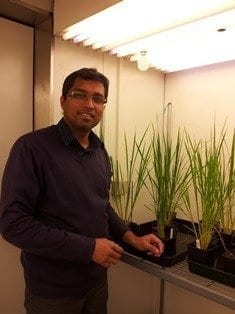
Wheat provides about a fifth of humanity’s food
It’s like an ongoing arms race – we’ve got to keep one step ahead of this changing pathogen
- Rust pathogens devastating crops in Africa, making a comeback in Europe
- Scientists have isolated the very first rust pathogen gene that wheat plants detect to ‘switch on’ resistance.
In a world first, science has leaped a step ahead of an old foe that has recently re-emerged in some parts of the world, where it has devastated crops because of its ability to evolve, undoing much of the hard work that began in earnest with the Green Revolution – using natural techniques to isolate the first rust pathogen gene that wheat plants detect and use to ‘switch on’ in-built resistance.
The breakthrough in research targeting the stem rust foe – historically the most dangerous pathogen of wheat – will mean suspect samples could be analysed within hours in an emergency rather than weeks, potentially saving crops from being destroyed.
“For the first time it will be possible to do DNA testing to identify whether a rust in a wheat crop anywhere in the world can overcome a rust-resistance gene, called Sr50, which is being introduced in high-yielding wheat varieties,” said Professor Robert Park, corresponding author from the University of Sydney.
“This will indicate whether or not a given wheat crop needs to be sprayed with expensive fungicide quickly to protect against rust – which would otherwise devastate the crop in a matter of weeks.”
Rust disease epidemics have emerged at times in tandem with carefully refined selective breeding in cereals; the disease is once again extremely damaging in East Africa and is making a comeback in Europe.
The new findings are being published in one of the world’s leading journals, Science.
PhD candidate and lead author from the University of Sydney Mr Jiapeng Chen, who sequenced and analysed the genome of a virulent rust isolate, said this was the first important step in addressing the diagnostic challenges posed by ever-changing fungi, which result in new rust pathogen strains.
Professor Park explained: “It’s like an ongoing arms race – we’ve got to keep one step ahead of this changing pathogen.
“The last major epidemic of wheat stem rust in Australia alone, in 1973, caused $AU300 million in damage – imagine what that would be today.”
Co-corresponding author, Dr Peter Dodds from the Commonweatlh Scientific Industrial Research Organisation, said demand for wheat in the developing world was expected to jump 60 percent by 2050 and in economic terms alone the ramifications were huge.
“Now that we’ve identified how stem rust strains are able to overcome Sr50 resistance – by mutation of a gene we’ve identified called AvrSr50 – this information can be used to help prioritise resistance genes for deployment.
“Our results so far show the plant immune system is able directly to recognise the fungal protein, said Dr Peter Dodds, from CSIRO’s Agriculture and Food team. “We are gaining a better understanding of the whole process – what’s going on at the protein level, at the gene level.”
Co-author Dr Kostya Kanyuka from Rothamsted Research, an agricultural science centre in the United Kingdom, said stem rust had been making a comeback in Europe, for example in Sweden as recently as this year, and was threatening Asia and the US.
“The highly virulent Ug99 race of the stem rust fungus – which emerged in 1998 in Uganda – has become even more potent as it has spread through Africa and the Middle East, with winds threatening to carry it into Asia,” Dr Kanyuka said.
US collaborators Professor Melania Figueroa, Professor Brian Steffenson and Dr Yue Jin were able to extend the results of the study by examining strains of the stem rust pathogen from other parts of the world, including the US and Africa.
“It is important to look at this gene in worldwide rust strains to gain a picture of where virulence is most likely to evolve,” Professor Figueroa said.
Professor Park, from the Plant Breeding Institute, part of the University’s Sydney Institute of Agriculture and School of Life and Environmental Sciences, said the results should also lead to a better understanding of how rust pathogens infect wheat, evading detection by the wheat plant, and causing yield losses.
“In addition to the immediate practical benefit regarding the important rust-resistance gene Sr50, our world-first finding could potentially have a longer-term payoff in the 10-15-year horizon,” he said.
A key element of the research was carried out by Mr Chen who initiated the work, partially funded by the University of Sydney through the affiliated Judith and David Coffey Life Laboratory in the Charles Perkins Centre.
The paper, “Loss of AvrSr50 by somatic exchange in stem rust leads to virulence for Sr50 resistance in wheat”, will publish on 23 December online in Science.
CSIRO animation of how rust attacks plants
Learn more: Wheat disease breakthrough to help feed the world










